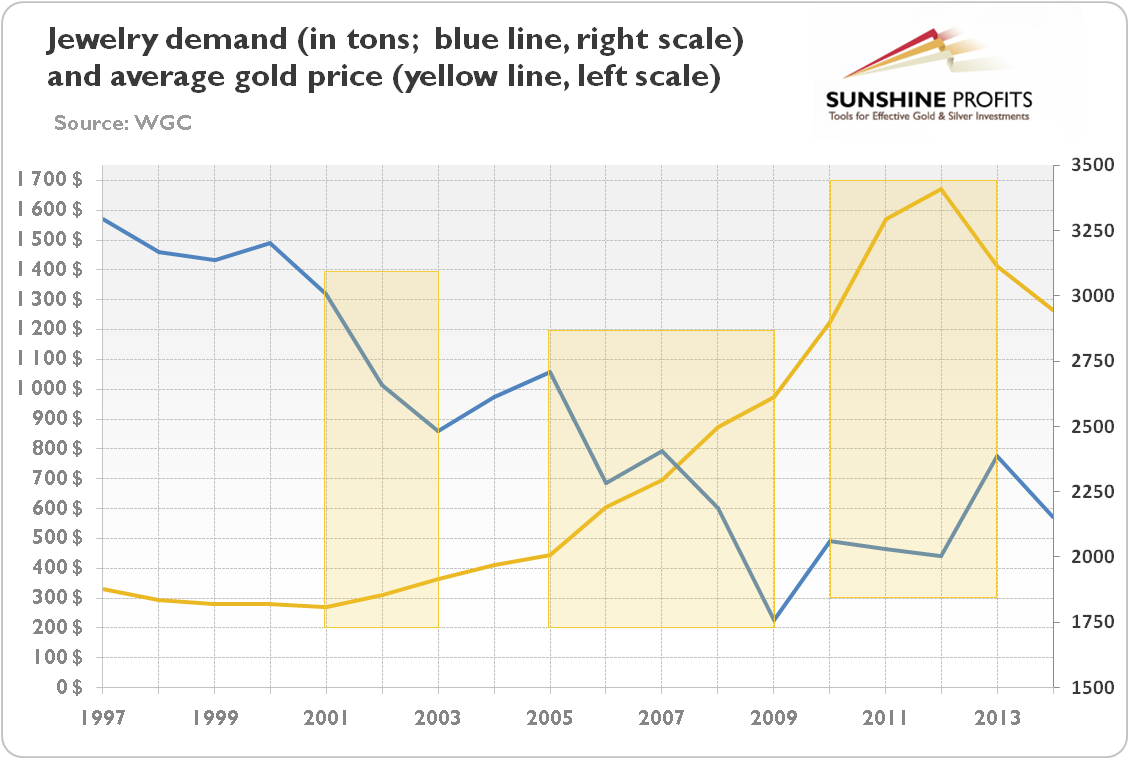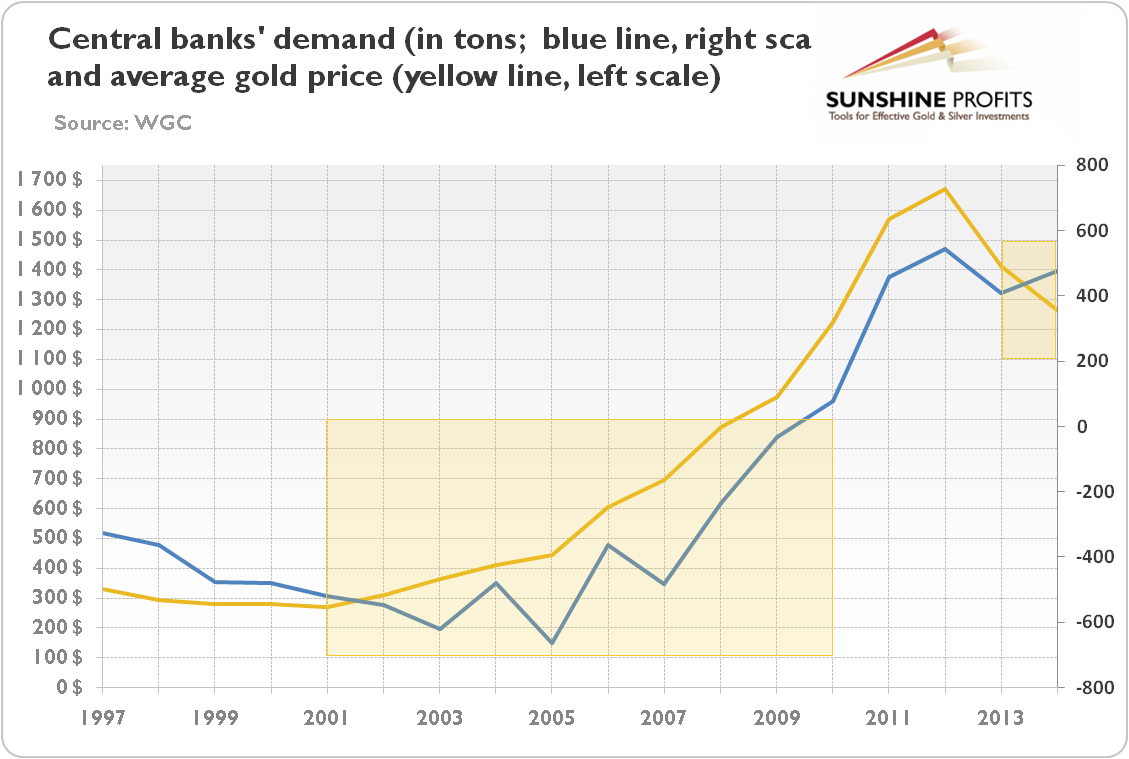Let’s start with the jewelry demand. There are countless articles in the financial press stating that demand for jewelry, especially from Asians, drives gold prices. Many analysts even suggest that the growing incomes in Asia, particularly in China and India, will spur demand for gold, which will make prices skyrocket (according to this article, the price of gold should double in the next 15 years thanks to the gold lovers from Asia). Unfortunately, they are all wrong. Why?
The reason is simple. The gold prices are not driven significantly by consumer demand, but by investment demand. Consumers do not drive prices, because when the prices rise, they buy less, and vice versa. Only professional investors can provoke a stable, sustained rise in the gold price as happened during the past bull markets. Indeed, the rising prices of gold in the 1970s and 2000s coincided with declining jewelry demand, while the bear market in 1980s and 1990s was accompanied with a steady rise in demand for jewelry (see: chart 1).

Jewelry demand was generally falling in 2000s, while the gold price was rising. The high in jewelry demand in 1999-2000 coincided with a 20-year low in the gold prices, while the low in 2009 occurred during the gold bull market. And more recently, gold prices fell by almost 30 percent in 2013, while gold jewelry demand saw the largest volume increase since 1997 (by 17 percent annually).
This is the exact opposite of what we might expect if the jewelry demand would have really driven the gold price. In reality, the gold price affects the jewelry demand significantly, not the other round way. This category of demand has high price elasticity, especially in the Western countries, where gold jewelry is bought almost solely for decorative purposes as a luxury consumption good.
By the way, the same applies to scrap supplies. Recycling is also very sensitive to changes in the gold price, so when the gold price rises, scrap supplies increase, and vice versa; thus, recycling follows the gold price rather than driving it.
To be sure, jewelry demand, especially in Asia, represents investment demand in disguise rather than simple consumer demand, but it means that jewelry demand can drive gold price only as an investment demand. Contrarily, as a consumption demand it can provide only some upward support and follow gold price rather than setting it.
So, don’t put too much weight on all these bullish analyses focusing on demand from India and China. The GDP per capita and disposable incomes have been rising there for decades, and have also done so during gold bear markets. Asian demand does not drive the gold price, but follows it. For example, in 2013, gold prices fell by almost 30 percent (also against Yuan), and Chinese households became the world’s heaviest buyers of the yellow metal, while Indian and Chinese demand fell in the first quarter of 2014, when gold prices recovered from earlier losses.
The demand from central banks is a bit more complicated, since they buy and sell gold based on political reasons concerning the value and safety of national reserves and their expected need for the metal, rather than to gain a profit. Therefore, their activity does not follow gold prices exactly, as it was demonstrated by the Bank of England, which sold 395 tons of gold between 1999 and 2002 when the market was at its lowest. But does central bank buying drive the gold price? We do not think so. Just look at chart 2.

As you can see, the gold price was rising since 2001, despite the fact that central banks were heavy sellers of gold from 1989 to 2009. Contrarily, the average gold price fell from $1,411 in 2013 to $1,266 in 2014, although central banks increased their net purchases from 409.3 tons to 477.2 tons.
Moreover, central banks possess only around 15-20 percent of total world gold holdings, while their annual purchases equal only the sum traded during a single day at the London market. It seems that central bank demand can put a floor under the price (or strengthen the existing market sentiment) rather than drive it.
The key point is that neither jewelry nor official demand drives the gold prices. Demand for gold jewelry is highly elastic and follows the gold price rather than sets it. Central banks’ purchases are relatively small and conducted mainly due to reserve management policy considerations (e.g., due to diversification), not because of the profit motive. In reality, the factor that really drives the price of gold is investment demand.
Would you like to know more about factors driving the gold prices and other important gold-related phenomena? We focus on the fundamental analysis in our monthly Market Overview reports; however, we provide also Gold & Silver Trading Alerts with clear buy and sell signals. If you’re not ready to subscribe yet, we urge you to join our gold newsletter today. It’s free and if you don’t like it, you can easily unsubscribe.
Recommended Content
Editors’ Picks
EUR/USD clings to daily gains above 1.0650

EUR/USD gained traction and turned positive on the day above 1.0650. The improvement seen in risk mood following the earlier flight to safety weighs on the US Dollar ahead of the weekend and helps the pair push higher.
GBP/USD recovers toward 1.2450 after UK Retail Sales data

GBP/USD reversed its direction and advanced to the 1.2450 area after touching a fresh multi-month low below 1.2400 in the Asian session. The positive shift seen in risk mood on easing fears over a deepening Iran-Israel conflict supports the pair.
Gold holds steady at around $2,380 following earlier spike

Gold stabilized near $2,380 after spiking above $2,400 with the immediate reaction to reports of Israel striking Iran. Meanwhile, the pullback seen in the US Treasury bond yields helps XAU/USD hold its ground.
Bitcoin Weekly Forecast: BTC post-halving rally could be partially priced in Premium

Bitcoin price shows no signs of directional bias while it holds above $60,000. The fourth BTC halving is partially priced in, according to Deutsche Bank’s research.
Week ahead – US GDP and BoJ decision on top of next week’s agenda

US GDP, core PCE and PMIs the next tests for the Dollar. Investors await BoJ for guidance about next rate hike. EU and UK PMIs, as well as Australian CPIs also on tap.